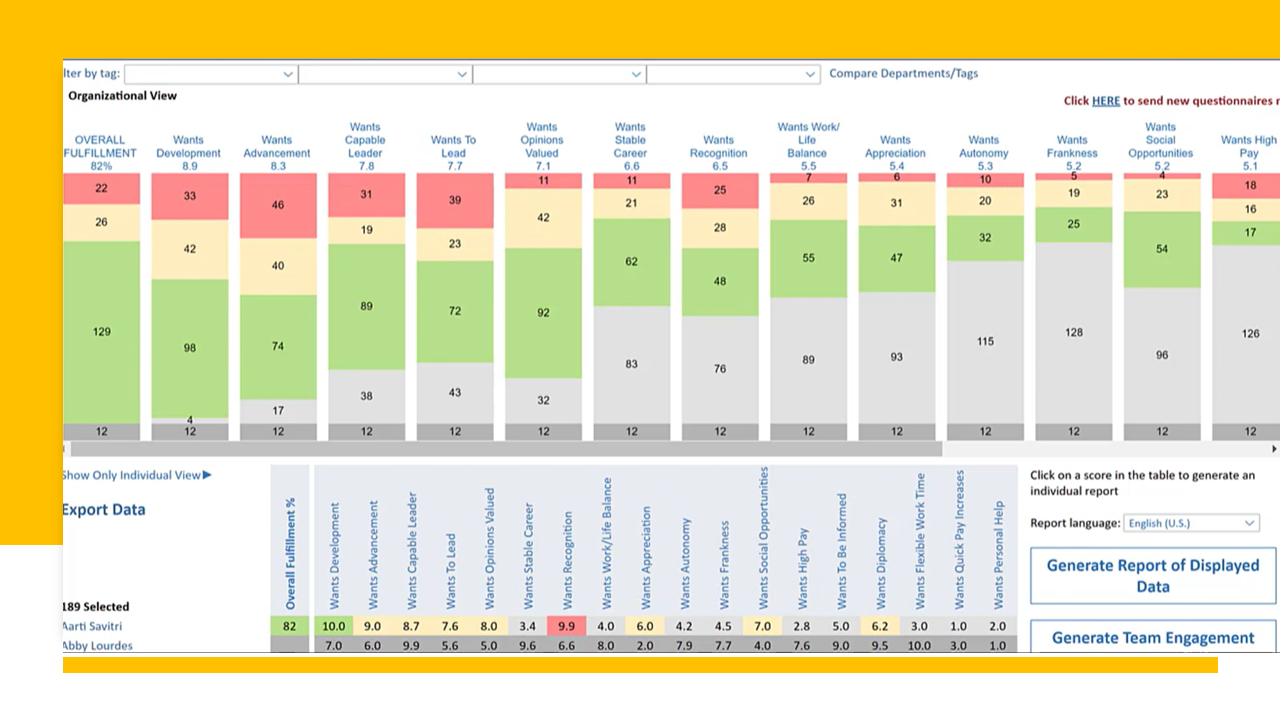Lead for Performance and Engagement Program
Purpose
To implement a program consisting of the right metrics, effective management development and critical process steps…
To achieve significant improvements in engagement/fulfillment and retention metrics by facilitating a process where managers exercise leadership leveraging causal engagement data in one-on-one discussions with each member of their team..
To set into motion a continuous improvement process to not only maintain first-time process improvements but to institute durable consistent improvement through a mix of attention to the right metrics, leadership development and disciplined consistent effort.
The process for improving Employee Experience by creating a mutually beneficial relationship between employee and organization with the optimal information
Most organizations conduct employee satisfaction surveys, eNPS, or so-called engagement/pulse surveys. These ask the same questions of all participants whether the issue is important to the individual or not. They are also anonymous so you can’t address an individual’s results directly. These results are analyzed by the organization and departments but because there are over 20 engagement factors that can be the driving influence for any one individual (advancement, money, public recognition, problem-solving, relationship, job security…), when they are averaged together, the usefulness diminishes.
Also, as has been well documented, most organizations struggle to improve significantly even with volumes of this kind of data. Unfortunately, the poor results don’t seem to matter, as the abundance of this anonymous data and the reports generated proliferate in many organization with little discernable benefit.
What’s the situation today with Engagement and Pulse Survey Data & Programs?
You can aggregate anonymous engagement pulse/ survey data and get some benefit especially if you haven't collected it in a while, however to get significant and durable impact and leverage, your managers need to understand and act upon individual engagement and fulfillment data. How fulfilled (which often equates to energized) is each employee on the factors that are important to them, individually.
This is how you move the engagement needle up and also raise fulfillment… AGILEdge
Level of Desire for (LDF):
(For most, goes from close to NO DESIRE WHATSOEVER to something they have to be seeking most of the time to feel right about things)
Intensity or Tendency to be (ITB):
(For most, goes from close to NONE to an addiction of some kind, something they have to be doing most of the time to feel right about things)
Development
Work/Life Balance
Opportunities to Earn Extra Incentives
More Money/Salary overall
Recognition (public vs private appreciation)
Change
Job Security
Helping Others
Having your Opinions Valued
Business/Finance Focus (From None to exclusively)
Being Part of team (Never to only…)
Appreciation
Advancement
To be Informed/kept in the loop
Flexible work time
Social Opportunities at work
Personal Help
Research / Learning
Building / making
Autonomy
In Control
Overt and Direct in communicating
Creative and Experimenting
In a state of flux
Systematic
Analyzing Scenarios
Engaged with people
Open Minded or Discussing things out...
Stressed
Deadline Pressure/last minute motivation
Teaching
Mechanical
Digital
Manual Work
Numerical Work
Leadership Opportunities
Project Management Opportunities
Working for a Leader I can really respect
Effect:
Engagement of Each Employee
Causes:
Individualized Understanding/Attention to the 2 to 5 Engagement Factors Key to
Each Employee from the List Below:
If you are treating engagement as a group or organization-wide phenomenon, you will likely not meet expectations; You can improve engagement some by doing the generic recognition, communication meetings, team events… but as you'll find and as data across 1000's of companies demonstrates, its minimal and often, fleeting. There is a better way, which aligns with what really causes engagement in your managers and in key employees.
Consider the concepts shown in the diagram above:
The first step is to understand what Engagement really is. What causes it? Engagement is purely an individual psychological phenomenon. You need to impact it individually and the bulk of the impact, is best done through the manager (in most scenarios).
To do this effectively, you need validated data on engagement factors that shows the degree of importance of each factor. Then, for each one that is important to the INDIVIDUAL, you need to know what their current level of fulfillment is. This data enables actionable understanding and with it, the manager can effectively deal with employee expectations and goals. It allows for root causes to be addressed. This assumes there is an effective management system and leadership skills in place.
How can an organization most effectively improve engagement?
When you use the e-Leverage Program
“The assessment itself is very powerful because it’s very real, it’s very personal, it’s very relevant. And if you combine that with some structured learning, we believe that you can get a big impact in terms of really directing these behavioral shifts. Coaching and feedback is extremely important to our organization as relates to our people managers.”
Conventional Engagement Efforts:
The Futility of Addressing Effects rather than Causes
THE OVERALL PROCESS
THE RIGHT DATA TO SUPPORT THE PROCESS
Organization, Department and Individual Data to Address Causal Issues
Engagement is…
The emotional commitment that an employee has to the organization and its goals. It’s a psychological phenomenon between the individual and the organization (and their manager prominently)
Overview of the e-Leverage Program
Inputs
Transformation
Outcomes
Clarity on Culture and the Direction you are trying to take it
Your past Anonymous Engagement data broken down can be helpful
Individual Behavioral Engagement and Fulfillment Data
Manager’s Feedback, Coaching and Communication skills reinforced
Manager’s understanding and preparation for 1:1 sessions with each employee
The 1:1 sessions
Results from 1:1 sessions
Joint learning, Action Plan, Development of Management System for Continuous Improvement





















